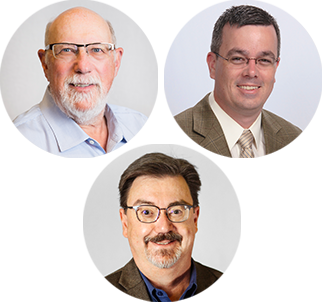CEC experts have conceptualized and implemented new technology and methods to help landfill owners and operators manage PFAS and landfill stability.
With the effects of both per- and polyfluoroalkyl substances (PFAS) and leachate dominating the current state of the solid waste industry, CEC’s experts found new, innovative ways to help our clients navigate regulatory concerns and the slope stability of their landfills.
Five of CEC’s waste management professionals developed new technology and methods to help our clients manage PFAS and evaluate the stability of their landfills, leading to lower costs and increased peace of mind about their facilities.
For their efforts in helping our solid waste clients and advancing CEC’s capabilities, Ivan Cooper and Bruce Reilly of CEC Charlotte, Jon Kitchen of CEC Boston, and Tim Mitchell and Dave Spang of CEC Monroeville were winners of CEC’s Innovation Award. Here’s a look at their innovations and how they’re helping.
Simplified PFAS Removal Technology

Known as “forever chemicals” because of their resistance to breaking down, PFAS are manufactured chemicals that are found in many consumer products, such as cookware, packaging materials, and firefighting foams.
Ivan, Bruce, and Jon helped one of CEC’s landfill clients navigate expensive and limited options for the treatment and disposal of leachate liquid generated from a landfill that contained PFAS.
“There have been a lot of efforts to develop advanced biological treatment for these chemicals, and they’ve had some success, but it’s not easy to implement or cost-effective,” Bruce says. “Liquids containing PFAS must be treated and disposed of off site, usually through a Publicly Owned Treatment Works (POTW), or on site through a National Pollutant Discharge Elimination System (NPDES) permit or direct discharge. The U.S. Environmental Protection Agency (EPA) recently mandated that NPDES permit holders must monitor and report PFAS concentrations that are leaving the POTW in the form of treated wastewater. This includes the POTW and landfills that have direct discharge permits.”
Public worry about PFAS is ever-increasing, with concern about the prevalence of PFAS compounds in POTW discharges and their impact on rivers, bays, and estuaries. The group developed a simplified treatment process that reduced the concentration of PFAS, allowing the client to treat their leachate at a POTW. Doing so lowered their cost when compared to other options and still met permit requirements.
As most landfills will be required to remove PFAS from landfill liquids over the next several years, owners and operators will seek options that help them meet regulatory requirements without breaking the bank or dedicating significant manpower to maintain.
“The EPA is in a monitoring and reporting mode, collecting this data so they can establish treatment standards or discharge criteria for this material,” Bruce says.
CEC’s technology is non-complex and could be scaled to reach clients nationwide, providing a cheaper, easier-to-maintain treatment and disposal option.
Method to Extend Cone Penetrometer Test (CPT) Depths in Landfills

As waste streams continue to evolve, there is now a greater need for landfill slope stability evaluations, subsurface investigations, and slope remediation designs. Many landfill owners and operators have had to seek new sources of revenue because of the changing waste landscape, including waste diversion, waste minimization, and recycling efforts. As such, they have accepted special waste types that had not been accepted in large quantities in the past, including liquids and sludges. Accepting those waste types affects the overall slope stability of the waste mass, and in some cases, this is compounding slope stability issues at sites that already have high liquid levels.
Cone Penetrometer Tests (CPTs) are performed to evaluate subsurface liquid conditions and provide detailed information on the strength of the waste materials. A shortcoming of this test is that it typically has a limiting depth of 75 feet. However, Tim developed a procedure to extend the depth of the test to 150 feet.
On the site that prompted him to try to increase the depths, Tim says he and the CEC team had made conservative assumptions about the deeper portions of the waste slopes at a landfill with a waste column about 300 feet deep. In making those assumptions, the site would have required extensive site improvements to enhance the stability of the slope to an acceptable level. However, Tim’s innovation allowed the team to analyze deeper into the waste mass and refine their assumptions based on data retrieved from the CPTs, while also addressing landfill gas safety concerns.
“This resulted in a significant cost savings to our client because they no longer had to perform the extensive site improvements originally required for the site,” Tim says. “There was a distinct difference in waste materials that were shallower compared to the deeper portions, giving us a better understanding of what the material properties were and the necessary actions to address with the client.”
After extensive coordination among CEC, the client, landfill gas consultants for the site, the landfill gas driller, an auger drill, and the CPT contractor, six deep CPTs were performed. The maximum CPT depth achieved was about 140 feet BGS, nearly double the previous maximum depth for the site.
Read more: Tim Mitchell is a Rising Star in the Waste Industry
Slope Monitoring Data Evaluation

When CEC recommends slope monitoring, it generally is for relatively severe cases of landfill slope movement. Because of the urgency required, Dave sought to streamline the process to reduce the amount of time it takes to analyze slope monitoring data. Slope monitoring has three goals: provide a leading indicator of potential large-scale slope movement, delineate the limits of the at-risk areas, and quantify the magnitude and direction of the slope movement.
“Obviously slope movement presents significant safety hazards to personnel at the site. Nobody wants to put personnel at risk by having employees work in a potentially unsafe area, but nobody wants to spend unnecessary money by possibly relocating infrastructure or operations if it’s not necessary, so what we’re trying to do with slope monitoring is assess the severity of a situation,” Dave says.
Operations at high-hazard landfills — those with steep/tall slopes — require multiple data monitoring points to provide important information about potential slope movements. In this case, client expectations for this project site included timely analysis of data from more than 70 locations and recommendations for landfill operational action to limit the potential for slope failures.
Dave developed a method that allowed the capture and analysis of data from the 70 locations, producing 400 graphs and calculations about potential slope movement within 15 minutes and presenting the information in graphical form. This innovation allowed for additional time for checking and analysis, and it improved deliverables for client communications.
CEC is currently utilizing similar methods to estimate and monitor pore pressures within the waste mass based on liquid-level measurements from piezometers and landfill gas extraction wells. CEC can now relay slope stability information within a day. Before, it could take a few hours to let clients know whether there was a problem, and up to a week to relay that information in an easy-to-understand way.
• • •
These innovations will be instrumental in ensuring landfill owners and operators are meeting all regulations and permitting requirements. These tools also will provide advanced insight into how they can safely operate and maintain their facilities now and in the future.



Post a Comment